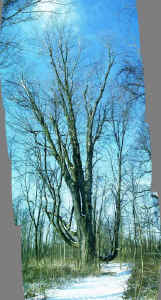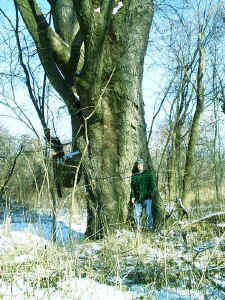ENTS
Report: China, Michigan, Red Maple and Lower Huron cottonwoods.
Hello ENTS and Michigan Big Tree Coordinator, Woody Ehrle,
Last Thursday, January 30, 2003, I tracked down the former
National
Co-champion red maple growing in China, Michigan. I was
initially thwarted
by car wrecks, road closures, and horrible maps printed from
on-line
sources. However, I finally found the address, 6700 Puttygut
Road. I pulled
into the snow covered drive which was liberally posted with
signs saying,
"No trespassing", "Keep out", and "Do
not enter- no exceptions". Daunted, I
finally mustered up the guts to knock on the door- engine
running- for
permission to see and measure the tree. Thankfully, I was
greeted warmly and
graciously given permission to see the tree. He said it was
behind the
yellow barn, by the river, can't miss it. Either the paint had
faded or the
barn was repainted without him knowing 'cause there was no
yellow barn. I
finally just parked and walked to the river. A small trail
followed the
river and lead to the tree, WHICH WAS HUGE!!! It is certainly
the second
largest red maple I have seen in girth and quite voluminous for
an old field
tree.

China Red Maple composite
|

China Red Maple base |
Let me pause here and discuss why this tree was so important for
me to
measure. Why would anyone drive over 700 miles to see one tree?
Well, it all
starts back in 1993... When I was working for the Great Smoky
Mountains
National Park mapping old-growth hemlock forests. On one survey
on Indian
Camp Creek, Tennessee, I came across a grove of huge red maples,
all over
14' in girth. As I measured the girths I saw another large maple
about 60
yards away. It looked huge, bigger than the ones I had just
measured. As I
worked my way through the rhododendron, I began to see just how
large it
was. 23' in girth! Seven feet in diameter! A RED MAPLE? Holy
moly, I had
found something for sure! When I returned home that night I
called Bob
Leverett, a new acquaintance at the time, and told him of the
girth. He
basically immediately made plans to drive 800 miles to see the
tree, "my"
red maple (he has me beat on the longest distance to drive to
one tree
award). He was enthusiastic to the point only Bob can get and
suggested that
it could be a new National Champion Big Tree. At the time, the
current
National Record was the tree in China, Michigan... Ok back to
Michigan.
According to the American Forests, National Register of Big
Trees, the
Michigan red maple in 1984 was 222" in girth, 179' tall,
and had an average
crown spread of 120' for a Big Tree total of 431 points. Bob
came down to
the Smokies on a rainy, cold day and we measured the Indian Camp
Creek tree
(heavily under the influence of chocolate chips). After numerous
joyous
expletives and cross-triangulation nightmares in rhododendron,
we determined
the tree to be 276" in girth, 137' tall and have an average
crown spread of
88' for a point total of 435. This final figure secured a place
as
co-champion (a re-measurment with laser clinometer now states
it's height at
141', equaling 439 points; an undisputed national Champ). For
me, my first
National co-champion tree was the starting point on my ENTS
mission to bring
truth in numbers. So, after measuring dozens of red maples in
some of the
best growing conditions in the world, how could a red maple in
Michigan grow
to 179' tall? This has always puzzled me, and was suspect from
the
beginning. So, already being up in Toledo, Ohio on a family
visit, I decided
to take the opportunity to visit the China red maple and see for
myself what
my original nemesis was like.
Now, I'd like to introduce to Woody Ehrle, again, my methodology
and the
ENTS baseline for accurate tree height measurements. We had
discussions
several years ago regarding how to obtain accurate measurements
of tree
heights, and the pitfalls and errors associated with
"conventional" forestry
techniques. The numbers listed below have an accuracy of +/- 1.5
feet, and
often less than half a foot. How do I know this? The Eastern
Native Tree
Society has done several seminars and demonstrations of this technique
that
has substantiated this claim. I have personally climbed and
drop-taped
measured an ENTS certified tree and found a ground-based height
measurement
to be less than 2-4 inches from actual height. Bob Leverett and
myself did a
demonstration in Virginia where he did the laser/clinometer
ground
measurements and I climbed the tree and drop-taped the same
point. We
independently obtained the EXACT same height.
Here it is: the laser rangefinder obtains a straight line
distance. The
clinometer obtains a vertical height angle above level (eye
level, in
degrees). For any given tree on flat ground, the laser distance
to the top
(or base) multiplied by the SINE of the angle to the top (or
base) = the
vertical distance. Add the top and base figures and you have the
total
cumulative tree height. The advantage of this method is that
tree lean and
crown abnormalities are irrelevant and the figures obtained are
at least
not-less-than numbers. With experience, you can pick out the top
leader with
minimal searching as you gain experience with the species and
crown
architecture. I urge all to scan the ENTS website for more
details.
So, with this is mind I bring you to the numbers I found for the
China,
Michigan Red Maple.
As mentioned earlier, the 1984 measurements indicated a height of
179'. I
surveyed the tree's canopy from eight (8) locations with respect
to the
base; the results are as follows:
NE 113.66' (sine top + sine base)
SE 120.45' "
N 108.76' "
W 113.77' "
W codom 110.84 "
S 109.61' "
Center lead 118.53' "
Straight up 117.25' (center leader; level ground eye height +
laser)
Thus, the tree has a maximum height of 120.45 feet, and has a
relatively
uniform canopy profile, as evidenced from ground observations.
WHAT WENT
WRONG?
I decide to measure the tree as stated in many big tree lists;
go out 100
feet from the base and measure the angle in percent (on a
clinometer) and
multiply the percent angle by 100 to get the height. This method
assumes a
straight tree with the highest unobstructed visible point to be
exactly
dead-center over the base (which never happens in real life).
So, out of
curiosity, I took four measurements like this: 100 feet from
the trunk,
measured top and bottom percent, and added the results together
for the
total height. Here are the results from four azimuths:
Height
W 148'
NW 129'
E 163'
S 166'
Obviously, the tree can't vary 37 feet in height based on which
side of the
tree you decide to measure! The 100 foot baseline rule DOES NOT
WORK on wide
spreading hardwood trees!
Speaking of spread, I measured the tree in four different
directions to
obtain maximum and minimum crown spread. As listed in the
National Register,
the average crown spread was 120' 20 years before I got there in
2003. The
figures I obtained were:
88.8'
78.7'
75.7'
75.3'
Taking maximum and minimum an average of 82 feet is obtained. I
have no
earthly idea, whatsoever, where 120' came from.
After nearly two hours with the tree I obtained and ENTS
certified the
following dimensions:
Girth 234" Height 120' Spread 82'= 375 AF Big Tree Points.
This is 56 points
less than listed 20 years ago and a 23% overstatement in overall
AF size.
????????????????????????????????????????????????????????????????????????????
????????????????????????????????????????????
Further down stream from the maple was a fantastic riparian
grove of
cottonwood, sycamore, ash, and bitternut hickory. I measured the
following
trees in a cursory survey:
Species Girth Height
Cottonwood 15'11" 126.7'
Sycamore 8'2" 109.45'
Red maple 14'3" 92.1'
Green ash 11'7" 111.3'
I then went to the Lower Huron Metro Park west of Detroit in
search of a
giant tuliptree nearly 20' in girth. The Michigan Big Tree
website listed
its location as on the Tulip Tree Trail. The Park Office had no
idea of the
trail and suggested looking in the Tuliptree Picnic area. I went
there and
found some nice tuliptrees but nothing near 20' in girth. I did
find and
measure a cottonwood at 19'7" in girth. Could this be the
tree,
misidentified? Anyway, perhaps more searching will yield a
monster
tuliptree. Here is what I found in a few minutes time:
Species Girth Height
Cottonwood 19'7" 117.7
Cottonwood 12'7" 131.17'
Tuliptree 7'1" 101.9'
Tuliptree 9'8" 113.7'
As darkness fell I spotted-and swear to return to-two HUGE
cottonwoods that
appeared to be over 18' in girth and in excess of 130' tall.
These trees
towered and dominated an out-wash terrace of the Lower Huron
River. They
will likely be the largest in displacement volume cottonwoods
ENTS has
surveyed. These trees are forest-grown and MASSIVE!
WHAT A DAY!!!
Will
|